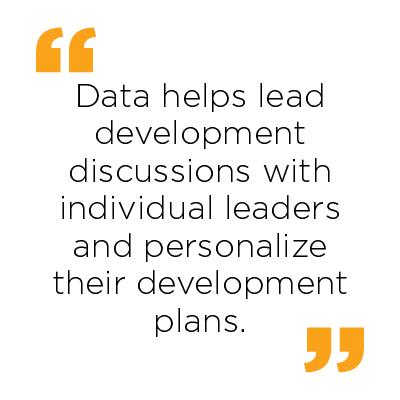If you’re not using data to find and develop leaders, you’re risking an expensive mistake. But a lot of companies don’t think about using data in the process. I can’t tell you how often companies ask me, “Why do a leadership assessment?”
There’s an easy answer. Data helps us make objective decisions, without relying too much on emotions. Companies must usually justify their investments through a decision-making process.
Consider that pilots spend hours in simulations before their first flight. And before you can fly a plane, you must pass rigorous testing and assessments. If you can’t prove your fitness to fly, you don’t earn your license. The training and assessment process is rigorous because even a single misstep can have severe implications.
The Importance of Leadership Assessment
So why don’t organizations assess their leaders before putting them in the pilot’s seat, or reassess their performance over time? Many companies choose leaders because they are good performers who “seem like” good leaders. And they often avoid providing feedback about areas of improvement—these conversations can be uncomfortable.
But failing to objectively assess a leader’s capabilities can have heavy consequences. First, it may create space for unconscious bias to influence the process. Second, poor leaders often have disengaged teams, lower productivity, and higher turnover. And these effects usually linger long after a leader has “left the building.” But without an assessment process, you won’t know which teams are at risk.
And these are just the potential costs of not assessing frontline managers. For each higher-level position, the cost of poor leadership grows. These leaders have more influence over people, strategy, and budget. At the executive level, one individual’s mistakes can cost millions.
With so much at risk, it’s amazing that companies still ask, “Why do a leadership assessment?”
Instead, they should be asking, “How can I use assessments to get better data about our leaders?”
How to Use Leadership Assessments
One of the first things to understand about assessments is that they shouldn’t be another process that HR owns behind the scenes. Rather, they should be a rich experience that benefits both the leader and the company.
Think of assessments as a flight simulation or audition. It’s a process to make sure the leadership candidate is ready for the job ahead, understanding what strengths they’ll bring with them as well as the areas they’ll need extra developmental support. An assessment gives the participant objective unbiased feedback about whether they are ready to perform on the job. Reviewing the results with the participant tells them where to focus their development efforts in order to improve.
Companies use this data in a wide range of ways. Some companies use it to create objectivity in hiring and promotion decisions. Others use the data to identify candidates for high-potential pools or to guide succession planning decisions.

But perhaps most importantly, data helps lead development discussions with individual leaders and personalize their development plans.
Data provides insight into their behavioral strengths and areas for development. It also reveals personality traits that could enable or derail future success. This self-awareness can deeply impact a leader’s career, helping them be effective in their current and future roles.
Group data from an assessment tool is incredibly powerful. As you review strengths and weaknesses, you may see “hot spots” where many leaders struggle with similar challenges. They need your help, and you have an opportunity to plan group development opportunities for them. You may also see how strengths and gaps align to support or undermine your company’s business strategy.
Bringing Assessment Data to Life
A few years ago, I worked with a hospital to help find candidates for their COO position, with the hope that this leader would eventually become CEO. One of the standout candidates who seemed like an obvious choice for the role was the hospital’s CTO, John. Everyone liked and respected John, and he was an outstanding performer.
But the hospital leaders knew better than to jump to the conclusion that John was the perfect candidate.
John’s assessment ultimately revealed that he wasn’t ready to step into the COO role. But he had potential. With the right support and development, he could be ready in a few years when the position opened up again as the COO stepped up to CEO.
The hospital then built John’s development plan around the assessment results. He built his business acumen through an MBA program. He developed his skills in the human side of leadership by serving as the hospital’s CHRO. John also participated in several coaching experiences, all guided by the assessment data.
And when the time came, John was ready to lead as the COO.
Assessments Are Investments in Career Growth
Everybody won in John's story—John, other C-suite leaders, and the hospital as a whole. But it almost ended very differently.
Before the initial assessment, John had been feeling that his career at the hospital may have been coming to an end. He’d been CTO for 12 years, and he had a feeling there was nowhere else to go. He started returning recruiters’ phone calls.
But the assessment changed everything. John saw that the hospital recognized his potential and was ready to invest in him. He recognized the role he could play in the hospital’s succession plan. And with the right (and a very personalized approach to) leadership development, he had a bright future ahead.
But the hospital's story doesn't end with John. As a matter of fact, it led to an overhaul of its leadership pipeline.
Building a Leadership Pipeline
When the board found out that they nearly lost John, they quickly understood the answer to the question “why do a leadership assessment.” They needed a data-driven strategy for every key leadership role.
They expanded the assessment process used for the COO position to key roles across the organization. For each role, leaders needed to be able to answer a key question: if the incumbent were to be promoted or leave tomorrow, was there at least one person ready to step up?
To answer that question, they created a color-coded system across the pipeline.
Green indicated that one or more candidates could step in right away. Yellow meant that they had someone who could step in, but they would need help and development support. Red signaled areas where no one from the hospital system could step in. Finally, they connected the hospital's performance to the strength of its leadership pipeline. Without data, it would have been impossible to connect business strategies and outcomes to talent.
Not All Assessments Are Created Equal
The answer to the question “Why do a leadership assessment?” isn’t quite as simple as, “Use data!” It’s important to consider what kind of data you’re getting.
Here’s an overview of different types of assessments you can use, and the data it provides:
- Self-Assessment provides an analysis of one's own goals, interests, skills, and experience. It could be used to personalize a training program to better understand participant needs. Self-assessments can also be used as knowledge checks.
- Leadership Test is a series of questions (usually closed-ended) designed to gather data on a leader’s knowledge, judgment, and/or preferences. Because they are online, fully automated, and easy to scale, these tests are often used to screen or shortlist a group of individuals.
- 360-Degree Feedback, also known as a multi-rater assessment, provides feedback from subordinates, colleagues, and supervisors. It also includes a self-assessment.
- Behavioral Interviewing focuses on past experiences by asking candidates specific questions about past performance. Interviewers collect data on behaviors, knowledge, skills, and abilities. Candidates describe a situation or task, their actions, and the results. Once completed, hiring managers compare the examples candidates provide against job requirements.
- Interview-Based Assessment with Business Case happens during a structured interview with a candidate using a business case as the platform. The interviewer determines strengths and gaps. The business case provides additional insight.
- Day-in-the-Life Assessments immerse candidates in a role at a fictitious company for up to a day. They require participants to manage emails, meetings, and other role-specific tasks. The experience includes exercises like analysis and decision making, leadership coaching, and partnering.
- Personality Tests involve a leader responding to a series of statements related to their style and preferences, usually delivered online or as a questionnaire. The goal is for participants to provide quick answers based on their immediate reactions to questions to get an accurate picture of their natural characteristics, motivations, and tendencies.
- Continuous Feedback provides leaders with frequent information about their performance from their managers, colleagues, and team members on an ongoing basis. The ongoing nature of continuous feedback is the critical ingredient most often missing for leaders as they focus on changing old habits or making new ones.
One Size Doesn't Fit All
Assessments provide information about individual candidates, but the same assessment won't work for every need. You must find the right fit. For example, 360-degree feedback won't identify leadership potential or readiness for the next role. That'd be like blacking out your windshield and relying solely on rear view mirrors to drive on the highway. It just doesn't work and, really, makes no sense.
It's about context. The right assessment type helps decision makers understand if candidates can actually do the job. It highlights their strengths, exposes where they need to improve, and whether their personal disposition makes them a good fit.
Early in my career at DDI, a client told me that it is impossible to make a completely objective hiring or promotion decision. But they emphasized that it is possible to structure subjectivity.
So why do a leadership assessment? Because using data is one of the best ways to make objective decisions.
Learn more about leadership assessment in DDI's Ultimate Guide to Leadership Assessment.
Bruce Court partners with organizations on all aspects of their leadership strategy. He’s experienced in every facet of leadership strategy design, development, and execution. Outside of work, Bruce likes to travel with his wife, Maureen. He loves eating at great restaurants as well as sampling good wine and craft beers. Bruce is also a huge fan of smooth jazz.
Topics covered in this blog

